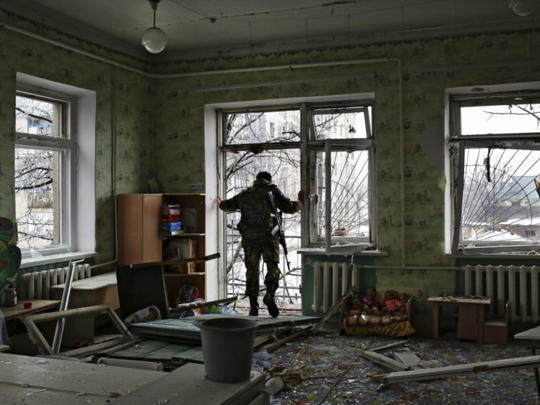
The new year has brought more misery to Ukraine. Separatist fighters, supported by Russian troops, have launched attacks in Donetsk and Luhansk. Diplomatic efforts have made no progress towards a settlement — or even towards firming up a ceasefire that has all but collapsed. The West, including the US, needs to get serious about assisting Ukraine if it does not wish to see the situation deteriorate further. That means committing real money now to aid Ukraine’s defence.
Following the intervention by regular Russian army units in eastern Ukraine in August, a ceasefire was hammered out in Minsk on September 5. Observance of the ceasefire terms has been piecemeal at best, with regular shelling across the line of contact.
After a December lull, fighting picked up again this month. The leader of the so-called Donetsk People’s Republic recently said he will take all of Donetsk. The next day, separatists, possibly augmented by Russian troops, rocketed the city of Mariupol, killing some 30 civilians.
Moscow has done nothing to promote a peaceful settlement. It did not withdraw its weapons, nor did it secure the Ukraine-Russia border, as it agreed to do in Minsk. Russian President Vladimir Putin continues to deny that his forces fight in Ukraine — even as Russian television shows soldiers in action wearing Russian insignia.
By all appearances, the Kremlin seeks to keep the conflict simmering to pressure and destabilise the Ukrainian government.
For the West, this issue goes beyond Ukraine. Russia has torn up the rule book that maintained peace, stability and security in Europe for almost 70 years and it has now used force to change borders. If the West does not push back, it could face challenges, even armed challenges, from Russia elsewhere that will require far more costly responses.
To date, the US and European Union (EU) have responded to Russia’s aggression with economic sanctions. These have inflicted serious damage on the Russian economy but have not yet achieved their political goal: Turning Moscow towards a genuine negotiated settlement.
The US has also provided military assistance to Kiev. But it amounts thus far to only $120 million (Dh441.36 million) and has been limited to nonlethal aid. Washington needs to do more to get Russia to change course. That means giving the Ukrainian military sufficient means to make further aggression so costly that Putin and the Russian army are deterred from escalating the fight.
Eight former US national security practitioners — the two of us, plus former US representative to Nato, Ivo Daalder, former undersecretary of defence, Michle Flournoy, former US ambassador to Ukraine, John Herbst, former deputy undersecretary of defence, Jan Lodal, former Nato European commander, James Stavridis, and former US European Command deputy commander, Charles Wald — have come together to issue the following recommendations for immediate action. (They will be released on Monday in a report called Preserving Ukraine’s Independence, Resisting Russian Aggression: What the United States and Nato Must Do.)
First, the White House and Congress must commit serious money to Ukraine’s defence: $1 billion in military assistance this fiscal year, followed by an additional $1 billion each in fiscal year 2016 and 2017. Congress should not only authorise assistance, as it did in the Ukraine Freedom Support Actlast year, but also appropriate funds.
Second, the US government should alter its policy and begin providing lethal assistance to Ukraine. To be sure, most of the above funds would go to non-lethal assistance. For example, the Ukrainian army desperately needs counter-battery radars to pinpoint the source of enemy rocket and artillery fire, which cause about 70 per cent of Ukrainian casualties.
But the Ukrainians also need some defensive arms, particularly light anti-armour weapons. The anti-tank missiles in the Ukrainian inventory are more than 20 years old and a large proportion of them do not work. US anti-armour weapons could fill a crucial gap.
Third, the US government should approach other Nato member states about assisting Ukraine, particularly those countries that operate former Soviet equipment and weapons systems compatible with Ukraine’s hardware. If the US moves to provide lethal assistance, we believe that some other Nato countries will do so as well.
Time is urgent. Spring arrives in three months in eastern Ukraine, and fighting could then achieve new intensity. We should help the Ukrainians deter that.
— Washington Post
Steven Pifer, who was US ambassador to Ukraine from 1998 to 2000, is a senior fellow at the Brookings Institution. Strobe Talbott, who was deputy secretary of state from 1994 to 2001, is president of the institution.









